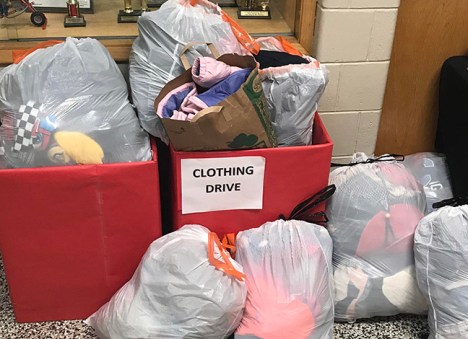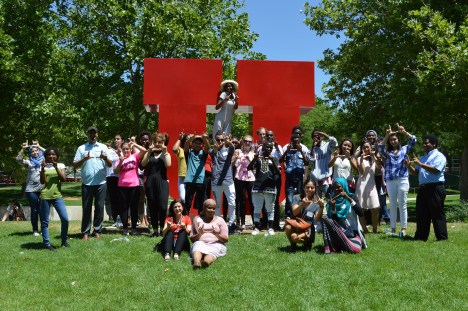Story and slideshow by BLAKE LANCASTER
When a refugee resettles in a new country, oftentimes they are in a new community with new rules, a new language and a new culture. How do they approach this challenging situation and become integrated members of American society? Organizations such as Utah’s Refugee Services Office can help with the transition.
Gerald Brown is currently an assistant director and state refugee coordinator at the Refugee Services Office, which is one of these organizations. The Refugee Services Office help refugees learn English, find and gain skills for employment and build connections with locals who can help show them the way things work in their new community.
Brown became interested in working with refugees during a year-long trip to Egypt with the YMCA where he experienced a culture with hardship unlike what we know in America. This sparked his passion for social justice. He went on the service trip expecting to help people, but when he finished he realized he learned the most.
Since his eye-opening service trip, Brown has worked in refugee agencies from Houston to New York to Cuba before becoming one of the godfathers of major Utah refugee programs.
For several years, Utah held monthly town hall meetings to discuss the state of refugee resettlement programs in Utah. In 2008, Gov. Jon Huntsman Jr. approved the addition of refugee services and Brown was appointed to direct and lead the new program toward success.
Brown hasn’t stopped serving refugees since then and can be credited with the efficient success the Refugee Services Offices is able to accomplish when it comes to the integration process.
“If you can accomplish integration, then you have the strongest community possible,” Brown said.
From all of his experiences, one of the things Brown has learned that he stresses is understanding the important distinction between integration and assimilation.
Integration can be defined as incorporating individuals from different groups into a society as equals. Though similar, assimilation means to adopt the ways of the new culture and fully become part of it resulting in an immense loss of cultural identity.
Danielle Stamos, public relations and marketing director for Catholic Community Services, said it is important we make it acceptable and comfortable for refugees to continue their traditions and maintain their culture.
“Not only do they preserve their culture, but they also share their culture with the community in Utah,” Stamos said. “I love when we see refugee communities creating their own events taking some of their traditions from their own countries and implementing them here.”
Catholic Community Services is another organization with programs in place to help refugees integrate into Utah. Catholic Community Services provides case managers to refugees as they are resettled in Utah who help them get on their feet. They provide them with housing, teach them the way the American system works when it comes to everyday life, help them learn the language, find them jobs, and much more.
One way Stamos suggested the everyday community member could help with integration is approaching refugees and being welcoming and friendly. If, however, you’re really feeling ambitious and eager to get involved, finding an organization that helps refugees and interests you to volunteer with can be rewarding to all parties involved.
“Once you work one-on-one with a refugee you can see daily how easy it can be to help support them in their goals and support them in maintaining their culture,” Stamos said. “There will always be a lot of fear out there of change and things that are different, but if we instead embrace it we can see how much more strong and beautiful our community and relationships can be if we share and work together.”
Nirmala Kattel provides a unique understanding of assisting the integration process of refugees as she is a refugee herself as well as an employee at the Refugee Education and Training Center.
The Refugee Education and Training Center is located at the Meadowbrook campus of Salt Lake Community College where Kattel also attends as a student. Kattel said one of the center’s most popular services utilized by refugees is help with jobs similar to Catholic Community Services, but the Education and Training Center is there to help after refugees no longer have their initial case manager.
Another popular service at the center that Kattel has noticed are the English classes. Some refugees come with very limited knowledge of the English language, which is a key hurdle for refugees to clear as once they can surpass the language barrier, it makes the rest of the steps in the integration process a little easier.
Kattel came to Utah as a refugee from Nepal in 2009 and quickly learned that isolation is another of the bigger barriers refugees face upon arrival for her and other refugees alike. She had to wait six years before the rest of her family was able to resettle in America.
“Refugees who come alone feel isolated and depressed missing their families and their past lives, so involvement and engagement in outside activities can help them through these feelings,” Kattel said.
Kattel said the elderly refugees can especially struggle with the isolation and loneliness. Since they don’t have a job or school to go to, it confines their reasons to leave their home. This seclusion can lead to difficulties with learning English and understanding the system of our community as a whole.
“The system is hard to understand at first. Refugees from almost everywhere come from somewhere with a totally different system in their countries or the refugee camps they waited in before coming here,” Kattel said.
Showing interest in refugees as a person and who they are culturally can help them with almost all of their integration barriers. Additionally, it can make them feel more comfortable in sharing their culture with their new community. Kattel said a friend with experience in the community always proves to be a valuable asset to refugees trying to make sense of their new home and sharing their cultural values.
Filed under: Immigrants & Refugees, Nonprofits, Organizations, Politics, Religion | Tagged: Catholic Community Services, Refugee Education and Training Center, Refugee Services Office | Leave a comment »










